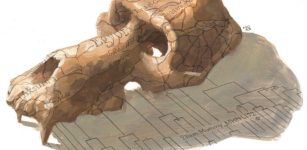Remarkable Kailashanatha Temple And Unique Passage Of Life Cycle Including Aging, Death And Rebirth
A. Sutherland - AncientPages.com - The famous Kailashanatha Temple in Kanchipuram, Tami Nadu India, was built in the 8th century during the reign of a South Indian Pallava Dynasty (275 CE to 897 CE) by the great king Raja Simha Pallava.
Kailasanathar Temple in Kanchipuram, Tamil Nadu. Image credit: Ssriram mt/wikipedia
It is a temple closely connected with the life history of saint Poosalaar , who was a devotee of Lord Shiva.
It is the largest temple built by the Pallavas, who became passionate temple builders. These kings were the first to build stone temples in the Tamil country and later experimented with carving temples in stone.
Dedicated to Lord Shiva, Kailashanatha Temple (means “Lord of the Cosmic Mountain”), was built in the tradition of temples that celebrate the cosmic mountain with the summit, which is not only the highest point of the earth but also the earth's navel, the point at which the Creation began.
Kailashanatha Temple is the oldest in Kanchipuram, a former Pallava capital (7th - 9th century) and one of the seven sacred cities under Hinduism. The city is approx. 75 kilometers (47 mi) from Chennai, the capital city of Tamil Nadu.
Some of the oldest books of the Sanskrit written about the 3rd or 2nd centuries BC, mention Kanchipuram, which is believed to have been part of the mythical Dravida Kingdom of the Mahabharatha.
It is the oldest temple in Kanchipuram, which was the capital city during the Pallava Dynasty and one of the seven sacred cities under Hinduism. Image credit: Ilamurugan
The temple, of which the architect is unknown, was commissioned by Narasimhavarman II commonly known as Rajasimha (r. 700 - 728 CE), a ruler of the Pallava kingdom, who is also credited with the construction of several other temples.
The structure is decorated with a large number of carvings, including many half-animal deities, especially popular during the early Dravidian architectural period.
There are 58 shrines, built into niches, which are dedicated to various forms of Shiva. The main shrine has a 16 sided Shivalinga carved in black granite. The Shivalinga in this temple is 10 feet high.
Kailasanathar Temple with an inner court or the circumambulatory passage with 58 sub shrines. Image credit: R. Mayooranathan - Public Domain
Perhaps the most remarkable and very unique feature of the temple is the so-called “circumambulatory passage”. This is a place associated with many great symbols.
The passage enables moving around a sacred object or idol. After climbing seven steps to reach this most unusual passage, devotees must crawl through it.
The crawling has a symbolic meaning of great importance; it is namely similar to passing through the life cycle including the aging process, death, and rebirth.
Crawling and finally leaving the passage symbolize coming out of the mother's womb and also explains Hindu's belief in rebirth.
Written by – A. Sutherland AncientPages.com Staff Writer
Copyright © AncientPages.com All rights reserved. This material may not be published, broadcast, rewritten or redistributed in whole or part without the express written permission of AncientPages.com
Expand for referencesMore From Ancient Pages
-
 Stunning Images Of Shackleton’s Lost Ship Endurance Discovered Off The Coast Of Antarctica
Archaeology | Mar 9, 2022
Stunning Images Of Shackleton’s Lost Ship Endurance Discovered Off The Coast Of Antarctica
Archaeology | Mar 9, 2022 -
 On This Day In History: The Battle Of Benevento Was Fought – On February 26, 1266
News | Feb 26, 2017
On This Day In History: The Battle Of Benevento Was Fought – On February 26, 1266
News | Feb 26, 2017 -
 On This Day In History: Magna Carta Sealed By King John Of England – On June 15, 1215
News | Jun 15, 2016
On This Day In History: Magna Carta Sealed By King John Of England – On June 15, 1215
News | Jun 15, 2016 -
 Controversial Theory Suggests Ancient Egyptians Were Founders Of Chinese Civilization
Archaeology | Sep 5, 2016
Controversial Theory Suggests Ancient Egyptians Were Founders Of Chinese Civilization
Archaeology | Sep 5, 2016 -
 Neith – Fearsome Egyptian Mother Of The Gods – Creator Of Sun God Ra, His Archenemy Serpent God Apophis And The Universe
Egyptian Mythology | Jul 9, 2018
Neith – Fearsome Egyptian Mother Of The Gods – Creator Of Sun God Ra, His Archenemy Serpent God Apophis And The Universe
Egyptian Mythology | Jul 9, 2018 -
 Does Yarmouth Runic Stone Describe A Trans-Atlantic Viking Voyage?
Artifacts | Oct 22, 2018
Does Yarmouth Runic Stone Describe A Trans-Atlantic Viking Voyage?
Artifacts | Oct 22, 2018 -
 A 1,500-Year-Old Basilica Re-Emerged Due To Withdrawal Of Waters From Lake Iznik
Archaeology | Sep 12, 2020
A 1,500-Year-Old Basilica Re-Emerged Due To Withdrawal Of Waters From Lake Iznik
Archaeology | Sep 12, 2020 -
 Manco Capac: Legendary Founder Of The Inca Dynasty Of Peru
Featured Stories | Jun 19, 2016
Manco Capac: Legendary Founder Of The Inca Dynasty Of Peru
Featured Stories | Jun 19, 2016 -
 How Many Ice Ages Has The Earth Had, And Could Humans Live Through One?
Featured Stories | Sep 26, 2022
How Many Ice Ages Has The Earth Had, And Could Humans Live Through One?
Featured Stories | Sep 26, 2022 -
 Ancient Urartu Settlement, Water Tunnel And Rock Tombs Found In Erzurum, Eastern Turkey
Archaeology | Dec 19, 2017
Ancient Urartu Settlement, Water Tunnel And Rock Tombs Found In Erzurum, Eastern Turkey
Archaeology | Dec 19, 2017 -
 Secrets Of Bolshoi Zayatsky Island – Mysterious Stone Labyrinths Of Unknown Purpose And Origin
Featured Stories | Oct 21, 2014
Secrets Of Bolshoi Zayatsky Island – Mysterious Stone Labyrinths Of Unknown Purpose And Origin
Featured Stories | Oct 21, 2014 -
 Uncovering 16th Century Scottish Royal Dockyards Used By King James IV’s Navy
Archaeology | May 24, 2018
Uncovering 16th Century Scottish Royal Dockyards Used By King James IV’s Navy
Archaeology | May 24, 2018 -
 Aditi – Primeval Hindu Goddess Who Is Source Of All Living Beings
Featured Stories | Apr 3, 2021
Aditi – Primeval Hindu Goddess Who Is Source Of All Living Beings
Featured Stories | Apr 3, 2021 -
 Mysterious Ancient Andean Waskiri Structure Built For Unknown Purpose Investigated By Scientists
Archaeology | Apr 14, 2023
Mysterious Ancient Andean Waskiri Structure Built For Unknown Purpose Investigated By Scientists
Archaeology | Apr 14, 2023 -
 Pax Mongolica: Time Of Peace And Stability That Helped To Spread Technologies And Inventions
Ancient History Facts | Mar 28, 2016
Pax Mongolica: Time Of Peace And Stability That Helped To Spread Technologies And Inventions
Ancient History Facts | Mar 28, 2016 -
 Can Baboons Solve The Ancient Mystery Of Punt?
Archaeology | Oct 25, 2023
Can Baboons Solve The Ancient Mystery Of Punt?
Archaeology | Oct 25, 2023 -
 Dangerous Anomaly Inside Mysterious European Mountain Remains Unexplained – Unusual Ancient Connections – Part 1
Featured Stories | Mar 13, 2021
Dangerous Anomaly Inside Mysterious European Mountain Remains Unexplained – Unusual Ancient Connections – Part 1
Featured Stories | Mar 13, 2021 -
 Beautiful Zeugma-Like Mosaics Unearthed In Sinop Province, Northern Turkey
Archaeology | Oct 17, 2020
Beautiful Zeugma-Like Mosaics Unearthed In Sinop Province, Northern Turkey
Archaeology | Oct 17, 2020 -
 Spectacular Victory Tower Dedicated To Hindu God Vishnu And Pioneered By King Rana Kumbha
Featured Stories | Apr 25, 2021
Spectacular Victory Tower Dedicated To Hindu God Vishnu And Pioneered By King Rana Kumbha
Featured Stories | Apr 25, 2021 -
 Huge Mass Grave With Remains Of Pirate Black Sam’s Crew Discovered In North America
Archaeology | Apr 3, 2018
Huge Mass Grave With Remains Of Pirate Black Sam’s Crew Discovered In North America
Archaeology | Apr 3, 2018



